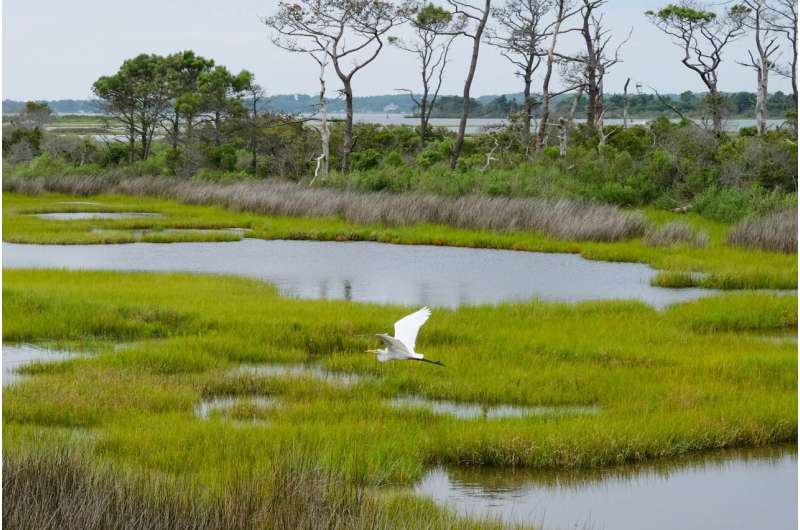The US is losing wetlands at an accelerating rate—how the private sector can help protect these valuable resources

Wetlands aren't the most eye-catching ecosystems. They include swamps, bogs, fens and other places where soil is covered by water most of the time. But they perform a , from soaking up floodwaters to filtering out pollutants and providing habitat for thousands of species of mammals, fish, reptiles, insects and birds.
In a high-profile 2023 ruling, , the U.S. Supreme Court greatly limited federal power to protect wetlands. According to one estimate, this ruling stripped federal protection from of wetlands across the U.S.
Today, the U.S. is losing wetlands, mainly to development and agriculture, . With Congress , new federal wetland protection laws are unlikely to be enacted in the next several years.
Some states have stepped up to fill the gap, but others have instead chosen to . This comes despite the fact that even before the Sackett ruling, people across the U.S. strongly favored .
We are environmental law scholars who recently conducted a study, to be published in a forthcoming issue of the , that explores how private environmental governance can protect wetlands. This approach uses and other practices such as to foster sustainability.
Relying on private action is not a substitute for regulation, but it can act as a stopgap while other legislative and regulatory efforts are developed. And it can complement new laws and regulations once those measures are in place.
Certifications and supply chain leverage
Corporations and nongovernment organizations have a variety of ways to encourage protection of wetlands.
First, certification bodies can develop standards for wetland-friendly goods, much like for products that promote safe working conditions, environmental protection and living wages for producers. Greater use of such standards can allow customers, investors and lenders to vote with their wallets. An example might be a label that identifies products made from ingredients grown on farms that preserve wetlands.
For construction, a gold standard already exists for the environmental certification of buildings: . LEED already incorporates some wetland protections, and its requirements can be bolstered to ensure protection of wetlands exposed as a result of the Sackett ruling.
Next, corporate pressure can use supply chain contracting to influence the sectors most likely to fill in wetlands: farming, construction and forestry. Corporations could require suppliers to agree not to damage wetlands exposed by the Sackett decision, in the same way that companies already use contracts to .
For example, Whole Foods Market requires suppliers to follow that includes minimizing their impacts on the environment, avoiding deforestation and seeking opportunities to conserve water. Similarly, Albertsons, the , requires suppliers to strive to .
The role of banks and investors
Large institutional investors and lenders can also play a role. Those with sustainability policies can insist that developers seeking funds follow pre-Sackett wetland protections.
Major banks have already shown various degrees of commitment to sustainability. In 2003, 10 leading banks from seven countries adopted the , a set of principles designed to "serve as a common baseline and risk management framework for financial institutions to identify, assess and manage environmental and social risks when financing projects."
This includes conducting environmental risk assessments of projects applying for financing, adopting measures to minimize and mitigate risks, and as a last resort compensating for unavoidable effects. We believe this list should be expanded to include assessing the risk of wetlands loss in project financing.
Several banks recently but pledged generally to . Nongovernment organizations can help protect wetlands by tracking financing for proposed developments in vulnerable areas.
Reducing flood risks
Insurance companies can also help fill the gap in wetland protection. Because wetlands are valuable buffers against floods, property insurers have a vested interest in reducing wetland losses.
Many California insurance companies facing rising costs due to climate change have . Similar decisions are occurring in other disaster-prone states such as .
Without access to insurance, businesses will be less likely to invest in these states. Reducing flood risks due to wetland destruction could help reduce risk for insurance companies.
Private insurers could refuse coverage to properties that significantly degrade wetlands no longer protected after Sackett, or they could make coverage contingent on binding commitments not to degrade wetlands. And conservation groups could work with private insurers to develop climate-focused coverage for particularly sensitive wetlands left uncovered after Sackett.
In an example of this approach, The Nature Conservancy, an environmental nonprofit, bought insurance in 2022 to fund restoration of Hawaii's coral reefs if they are .
Retail customers, employees, community members and nonprofit groups can place economic pressure on companies to incorporate such protections into their operations. This kind of private pressure has already spurred companies to pledge to . Until states and Congress pass new laws to prevent wetlands from being destroyed, we see action by businesses and nongovernment organizations as the most promising substitute.
Provided by The Conversation
This article is republished from under a Creative Commons license. Read the .![]()





















